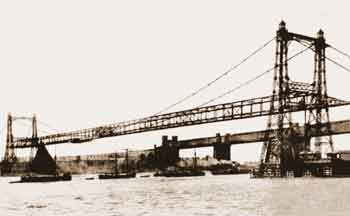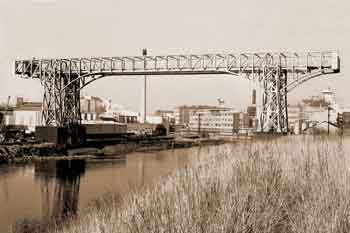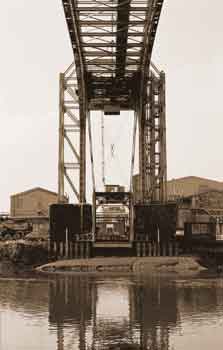
Towards the end of the 19th century and into the early years of the 20th century, the problem of spanning wide rivers and canals, while maintaining headroom for navigation, was becoming a problem. The solution adopted to solve this problem was the transporter bridge that, in effect, was an aerial ferry that carried a segment of roadway (or platform) across the span. This problem was especially acute in flat country or urban areas where approach roads were at a low level making fixed bridges impractical. A typical transporter bridge consisted of a tower on either side of the span, which supported a girder at a sufficient height to be clear of navigation. Vehicles were then carried across the span on a large segment of roadway suspended by cables from a trolley running on rails along the girder.
This idea was first put forward in Britain in the 1870s but the first bridge to be built was Vizcaya Transporter Bridge designed by the French engineer, Ferdinand Arnodin, at Portugalete/Getxo, Greater Bilbao, Spain. This was completed in 1893 with a span of 164m.
Some 25 transporter bridges have been identified throughout the world of which five were in Britain, namely:
 |
The Widnes-Runcorn Transporter Bridge in 1905, the year it opened. This bridge was in use until 1961 when it was demolished and replaced by a high-level, steel-arch bridge. |
 |
 |
Bank Quay (or Warrington) Transporter Bridge, Feb 1980. This bridge across the river Mersey was built in 1916 and has been unused since c.1964. It is privately owned and it was built to connect the two parts of the large chemical and soap works of Messrs Joseph Crosfield & Son Ltd. This bridge is listed Grade II*, List Entry No. 1139433. Due to its poor condition it is on the Buildings at Risk Register. |
Bank Quay (or Warrington) Transporter Bridge, Feb 1980. This view of the bridge shows the road platform suspended by cables from a trolley running on rails along the girder. |
Devil’s Dyke Transporter Bridge, from a drawing by William Axon, 1897. This bridge spanned the deep valley of Devil’s Dyke on the South Downs, 5 miles north of Brighton, West Sussex. The valley is nearly a mile long and it is the widest ‘dry valley’ in Britain, i.e., no water flows through it. |
|